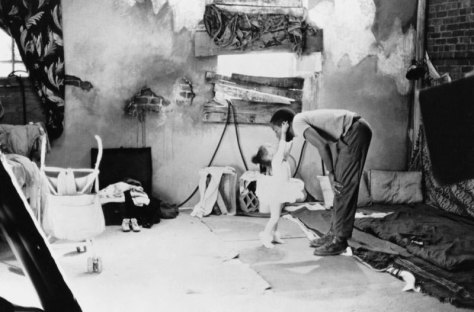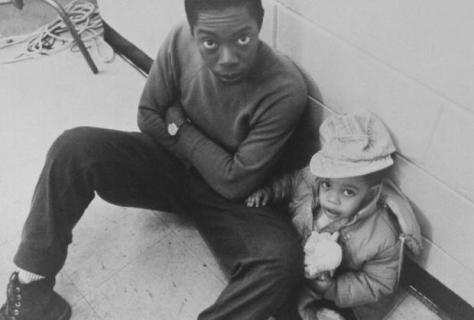
I barely knew a thing about Charles Lane this time last week. But since Saturday night I have been trying to find out as much as I can. Twenty five years ago, Lane directed a modern silent film of great style and bounteous charm, which was warmly received at the time, but has barely been heard from since. Like so much in the history of silent film, Sidewalk Stories (1989) is buried treasure, though from a rather more recent past. The good news is that the tail end of 2014 may finally be the time when Sidewalk Stories gets its due. The likelihood is that you will get a chance to see it soon, and I definitely recommend you take the opportunity when it arises.
As a film student, Lane was apparently very sniffy about silents, but when a chum insisted that he catch a screening of The Gold Rush, he relented. Chaplin worked his magic, and Lane was hooked for life. The influence of Chaplin is powerfully strong in Sidewalk Stories, a silent black-and-white comedy shot on the streets of New York; Lane directs and stars in the film, which has more than a touch of The Kid about it. Lane plays a street artist, who sleeps rough in a derelict building in Greenwich Village (yes, you might say he was a tramp), but, through some convoluted circumstances finds himself in charge of a small child. No messing about: the Artist’s foldup easel looks uncannily like the window-repair kit Chaplin equips himself with in the earlier movie. It’s clear that Lane has an eye for the most devilish of details. Lane’s two-year-old daughter plays the Child, and although it seems strange to critique a toddler’s performance, she’s fantastic and of course, utterly adorable. Sandye Wilson, an elegant woman with a devastating smirk, plays the Artist’s bewildering and benevolent love interest. Lane’s character is a cheeky one, all right, and a dreamer too: a nonchalant riff on Chaplin’s Tramp, which retains the sweetness and the acrobatics of the original but with a pared-down ego. Lane’s Artist is a more of an everyman than a showstopping clown: a little guy in a zip-up denim shirt and cargo pants with neatly cropped hair. Perhaps it’s because the big city is just a wee bit more terrifying in the late 80s. The Manhattan of this movie is perniciously hostile: crushing Lane’s character, and maybe squashing his performance a little too.

No matter. Here’s why Sidewalk Stories is easily worth 97 minutes of your precious time. It’s funny, it’s touching, it’s very clever and it has a quite remarkable lightness of touch. There’s some virtuoso material here, including some fantastically choreographed fight scenes and (a first for a silent movie?) a fantasy slapstick sex nightmare. There’s not a single intertitle here either. Most impressive of all perhaps is a sustained tracking shot early on that takes us from one end of a street in the Village to another, from the panhandlers and street sleepers, to the Artist’s patch where he and his fellow dancers and magicians are busy making believe that they are anywhere but urban hell. There’s some comic business with a piece of string and two beds that is simultaneously hilarious and terribly sad. I also enjoyed the way that a laugh-out-loud, but silly, gag at the start of the movie with yuppies grappling over a yellow cab (it’s the 80s, I’m allowed to call them yuppies) was replayed later on with a more sinister meaning. I particularly liked the fact that the second time around the carfight takes place during a chase that’s straight out of Harold Lloyd’s Speedy – Lane was clearly in close touch with his New York silent forebears.
I can’t lie to you, there’s something else that’s refreshing about Sidewalk Stories. The New York here looks a lot more like the New York I have been to than the one I see in the movies. We certainly didn’t see many black faces in films in the 20s, which might be forgivable. The fact that we still don’t definitely isn’t. Sidewalk Stories has an almost entirely black cast, and I wish that that weren’t worthy of comment. A quick scoot through the IMDB listings revealed that Sidewalk Stories wasn’t a springboard to success for its black actors, though. There is a future star in the cast list, however – a young Edie Falco, who spends all her brief screen time necking in the back of a horse-drawn carriage.

Sidewalk Stories takes place in and around Washington Square, which in 1989 was a tough neighbourhood going through a tough time. If you think that the clowning and sentimentality of a Chaplinesque movie are unsuited to the time and place then perhaps you don’t know your Chaplin. South London in the late 19th century had its fair share of mean streets. Lane knew this for sure, and what will really linger with you about Sidewalk Stories is how he takes that idea, that disconnect, and runs with it. The silence in this film is like a held breath. The Artist is trying to keep his bubble intact – a bubble where street brawls are really ballets, a windfall is alway just around the corner and pretty rich girls will invite a tramp like him to their swanky apartment for fancy chow and fancy wine. The dream of this plucky guy, his adopted daughter and their kind friends taking on the big city and winning is incredibly attractive, and very cinematic, but it’s just a dream. Reality intrudes, brutally, several times during the running of the movie, and each time the Artist dusts himself off and lives to fight another day. With each bruising he gets, the gulf between him and the Young Woman he has fallen for grows wider …

I made the mistake of reading this review by Roger Ebert before seeing the movie, which is beautifully written, of course, but led me to expect I would hate the ending. I wasn’t a fan of the same ending when I saw it elsewhere not so long ago, after all. I won’t give it away here (don’t follow the link if you don’t want to know), but I can tell you that I left the cinema just a little bit heartbroken. It worked for me.
So whatever happened to Sidewalk Stories? After the rave reviews and the Cannes applause, it was quietly forgotten about by its distributor and never had a home video release in the States. Disney fancied remaking it with sound, and colour, and a young Tom Hanks, but never quite got around to it – for which we should probably be thankful. Lane was busy working on a fish-out-of-water comedy starring Lenny Henry at that point anyway. You won’t be surprised to learn that the Henry project was a flop. As the 90s spun around, Lane was being championed as a star of New Black Cinema, alongside Spike Lee and John Singleton. Sadly, he never had the career he dreamed of, but maybe the rebirth of Sidewalk Stories will change all that.

Sidewalk Stories has been recently restored and will be released on DVD and Blu-ray by Kino Video on 7 October in the US.
I attended the Nobody Ordered Wolves screening of Sidewalk Stories on Saturday 7 September, which was part of the Scalarama festival, with all profits going to Open Cinema, a film-based charity that helps socially excluded people. Instead of Marc Marder’s original score, Stephen Horne accompanied the film on a small orchestra’s worth of instruments. It was wonderful, needless to say, and very funny, but the other Scalarama screenings and the forthcoming DVD/Blu-ray release will feature Marder’s original score.